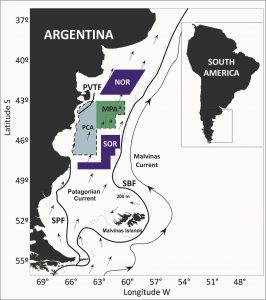SACC: An international consortium for the study of ocean related global and climate changes in South America (SGP-CRA 2076)

Project information
Servicio de Hidrografía Naval (Argentina)
This project follows the research started in CRN 2076, with the same title.
Executive summary
Oceans play a significant role in the global climate system; they sequester greenhouse gases, move heat from the equator to polar regions and control the global hydrology. The global Oceans, especially their continental shelves, have soaked up one third of the man-made CO2 emissions since the mid 1800s. Oceanic phytoplankton produces half of the Earth’s chlorophyll, and half of this is found on continental shelves which occupy only 9% of the global ocean area. Researchers in this project are studying exchange processes between the deep ocean and the continental shelf of eastern South America, and how such exchange impacts on the success of shelf species. Our hypothesis is that most of the shelf water transfer to the deep ocean occurs along the Subtropical Shelf Front (STSF, see image at right). Direct observation, historical data and numerical simulations all contribute to understanding ocean circulation and the responses of the ocean biota.
Goal
To determine the mechanisms responsible for the export of shelf waters to the deep ocean and its biological and biogeochemical implications.
Specific objectives
Determine whether the STSF is a preferential site for shelf/deep ocean exchanges.
Determine the changes of the physical, biological and biogeochemical characteristics of shelf waters along the STSF and their short-term variability.
First results
The Patagonia shelf, which covers 4% of the global continental margins, absorbs about 17 Tg C yr-1 (million metric tons of carbon per year). The project contributes to a better understanding of the carbon sequestration processes.
The significant fishery on the shelf break, with about one million tons of fish and squid landed every year (~1.5% of global production) shows strong interannual fluctuations; the project contributes to understand the variability of the commercial resources.
Development of state of the art ocean models that display realistic features of the circulation and reveal upwelling mechanisms which sustain the productive shelf break region.
Freshwater input from the Rio de la Plata and Patos Lagoon plays an important role on the ecosystem production and regional diversity in the SW Atlantic.
Outreach

SACC (IAI CRN 2076) summarizes their evaluation of the effects of a large-scale offshore marine protected area (MPA) located on the SW Atlantic Patagonian shelf:
¨We evaluated the effects of a large-scale offshore MPA located on the SW Atlantic Patagonian shelf (43ºS 63ºW) on the demersal fish assemblage. MPA effects were studied employing a five years database collected by a scientific research vessel in protected and fishing locations, before and after the MPA establishment, and fishing effort distribution was studied analyzing extensive databases from the national Vessel Monitoring System, provided by the National Undersecretary of Fisheries. Results show an increasing trend of abundance of the demersal fish assemblage, of abundance of the target and non-target fish species, of hake juvenile size and proportion inside the protected area. Higher fishing pressure in the boundaries of the MPA suggests better catches in their surroundings than in distant areas. This information was reported to INIDEP (National Institute of Fisheries Research and Development), the Argentinean institution that advises on fisheries management to the Federal Fisheries Council. The implementation of this protected area closed to trawling in the Patagonian shelf and its effective compliance benefits the conservation and management of marine resources. This study supports the case for large-scale MPAs in continental shelves.”
Link to source
Project investigators
Alberto Piola – apiola@hidro.gov.ar
Servicio de Hidrografía Naval (Argentina)
Co-Investigators
Kenneth H. Brink (WHOI, USA)
Marcelo Barreiro (U. Rep., Uruguay)
Edmo J.D. Campos (IO, USP, Brazil)
Ricardo P. Matano (Oregon State University, USA)
Hermes W. Mianzan (INIDEP, Argentina)
Osmar O. Möller Jr. and José H. Muelbert (FURG, Brazil)
Oscar Pizarro (U. de Concepción, Chile)
Project web site: http://sacc.coas.oregonstate.edu/~sacc/index.php
Students
Anahi Brun, Doctorate, Universidad de Buenos Aires, Argentina.
Angel A. Miranda Valencia, Undergraduate, Universidad Ricardo Palma, Peru.
Augusto Muniz Cavalcanti, PHD, Universidade Federal do Rio Grande, Brazil.
Bárbara C. Franco, PHD, Universidad de Buenos Aires, Brazil.
Carla Aseff, PHD, Universidade Federal do Rio Grande, Brazil.
Carla Derisio, Post Doctorate, INIDEP, Argentina.
Carolina Kahl, Doctorate, Universidad de Buenos Aires, Argentina.
Caue Zirnberger Lazaneo, Master, Universidade Federal do Rio Grande, Brazil.
Daniel Valla, Undergraduate, Universidad de Buenos Aires, Argentina.
Daniela Risaro, Undergraduate, Universidad de Buenos Aires, Argentina.
Deepak Cherian, PHD, Universidade Federal do Rio Grande.
Fabio Boeira Dias, Master, Universidade Federal do Rio Grande, Brazil.
Felipe de Oliveira Torquato, Master, Universidade Federal do Rio Grande, Brazil.
Heline Oliveira, Master, Universidade Federal do Rio Grande, Brazil.
Ignacio Gianelli, Master, Universidad de la República, Uruguay.
Javier Rabellino, Master, Universidad de la República, Uruguay.
Jennifer Sinclair, PHD, Oregon State University, USA.
Jonathan Correa Acosta, Master, Universidad Nacional Mayor de San Marcos, Peru.
Luciano Padovani, PHD, INIDEP, Argentina.
Luis Carlos Pinto de Macedo Soares, PHD, Universidade Federal do Rio Grande, Brazil.
Marcos Abe, PHD, Universidade Federal do Rio Grande, Brazil.
Marcos Andrade, PHD, Universidade Federal do Rio Grande, Brazil.
María V. Romero, Other, INIDEP, Argentina.
Mariano Tonini, Post Doctorate, Servicio de Hodrografía Naval, Argentina.
Marnia Marrari, Post Doctorate, Servicio de Hodrografía Naval, Argentina.
Micheli Duarte de Paula Costa, PHD, Universidade Federal do Rio Grande, Brazil.
Miriam Vergani, PHD, INIDEP, Argentina.
Mirian Jaimes, Undergraduate, Instituto del Mar del Perú, Peru.
Patricia Alcántara, Undergraduate, Instituto del Mar del Perú, Peru.
Ricardo de Lima Costa, PHD, Universidade Federal do Rio Grande, Brazil.
Vanessa Bolfoni Schmitt, Master, Universidade Federal do Rio Grande, Brazil.
Victoria González Carman, PHD, INIDEP, Argentina.
Vincent Combes, Post Doctorate, Oregon State University, Francia.
